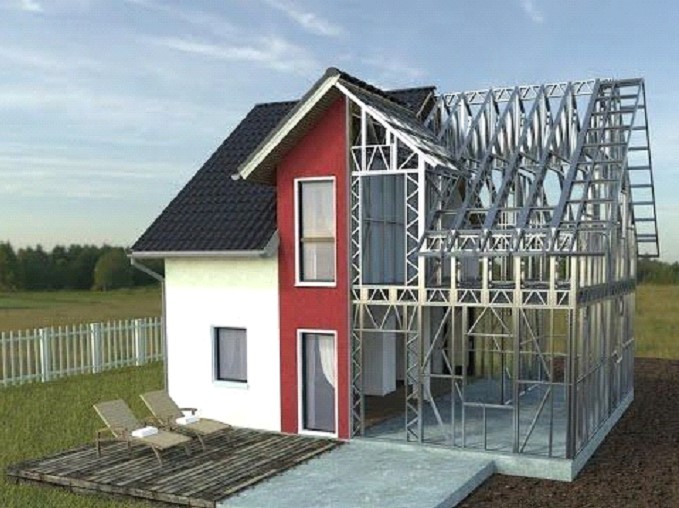Prefab Construction for Homes
Prefabricated Construction is a process of constructing buildings where components are manufactured separately and transported to the construction site where it is assembled, instead of being manufactured directly at the site.
Prefab construction is hardly new. What is new is the idea that this method of construction can be used to revolutionize the entire construction industry.
Prefabricated houses are undoubtedly better than on-site construction in almost every sense. These fashionable safe structures are built in a controlled environment by highly skilled professionals while saving time, money and a lot of other resources for the owners.
A prefabricated house has multiple advantages from being eco-friendly to being pocket-friendly. These are a perfect choice for modern-day housing.

Prefabricated Homes using LGSF:

The most advanced form of prefab construction is Light Gauge Steel Framing technology.
LGSF structure construction is a quick and easy solution for single to multi-story buildings. Light Gauge Steel Frame construction uses cold-formed steel as the primary construction material. LGSF can be used for roof systems, wall systems, floor systems, roof panels, decks and also for the entire building
Light Gauge Steel Frame construction is made of Cold-formed steel (CFS) and it has several advantages such as high strength to weight ratio, dimensionally constant, easy to handle, cost-effective, lightweight, vermin resistant, and can be fabricated with ease to a wide range of products and sizes with nearly no material wastage. The top benefit of LGSF structure construction is that; it is sustainable whose material properties that do not change with time.
Steps of building an LGSF Prefab Home:
If you are planning to build a house of your own or you are just curious to know, this article will take you through the step-by-step of building a light gauge steel framing (LGSF) or Prefab home:
Step 1: The Idea:
The procedure begins with the mere idea of your future home, and suddenly you’re looking at designs and styles to upgrade your home. But, before taking any further steps, keep in mind your family routine and habits.
Also, it’ll be wise to create a rough budget beforehand, as your budget sets the bar for how much you can spend on the various aspects of the house, like floor area, design choices, and more. Once you have done the planning you are all set for the next step.
Step 2: Draft your Prefab Design:
It is time to reach out to a prefab house professional with your sample photos, ideas and your rough budget plan. Involving a prefab builder, like Stratus Steel, in the process will help you maximize your budget:
● The professionals will help you with the best options, requirements, approvals and other necessary paperwork.
● Builders are trained to offer you special solutions which might improvise the functionality of your steel house framing.
● Preliminary designing can be made with ease.
You can do a lot more with a Prefab design if you are new to the prefabricated construction industry.
Step 3: Make an overall Project Budget:
Except for the prefab structures, there is a lot of other work to be done as well. So, it is best to reach out to a trusted prefab house builder who can provide you with all-round support or keep these expenses in mind while drafting your budget:
● Groundwork and Foundation
● Home Structures
● Windows and Doors
● Roof Cover
● Interior Finishes
● Technical Installation
● Construction Site
Step 4: Choose the Manufacturer:
Generally, this process is considered time-consuming considering the variety of options available in the market. To pick up the best manufacturer for your prefab home:
● Look for some answers to your doubts about prefab houses.
● Contact and Visit some manufacturers to understand their working process.
● Check online Reviews and Testimonials of other customers.
Step 5: Execution:
Once you are done with all the planning and selection, now it is time for execution. This is more of a technical process and commonly takes up to 4 to 12 weeks.
This step requires a lot of designing, visuals and communication among the site workers and contractors. Do not forget that it is very significant to leave appropriate space for electrical connections, plumbing and other fittings.
Step 6: Prepare the location:
This is the most significant step because this will be the foundation of your next home. Check the site for any issues.
Pay attention to quality and detailing and also keep in mind the related factors while preparing the site and begin with the production accordingly.
Step 7: Assembly:
You do not have to do a lot of work in this process, thanks to the LGSF or steel house construction. The time taken for the assembly process is subject to the size of your house. A single-family modular prefab house is generally assembled within a couple of days.
Step 8: Technical Installation:
Typical installations include plumbing, electricity, ventilation, heating, and communications.
Once the structure is up, it is now time for the general contractor to start the process of technical installations. It might take a few weeks for the overall technical job to be finished.
Step 9: Interior Finishing:
This process needs to be done with patience as any rush or carelessness might result in some unpleasant finishing or cracks on the walls. This process will bring up the final vibe of your house.
It might take somewhere from two weeks to a few months which completely depends on the size of your house.
Step 10: Handing Over:
Now you are all set to settle in your new house. With all the steps done and your house approved it is time to call over a few friends and have an amazing housewarming party.
Conclusion:
We are here to make the whole process a lot more convenient for you.
Get in touch with Stratus Steel for expert support for your prefab home needs in India.
You can reach us at work@stratus-steel.com or call us at 9156551673.
To read more about us, visit www.stratus-steel.com and www.houseable.in.

